Category: Idaho National Guard
A day in the life of an A-10 fighter pilot
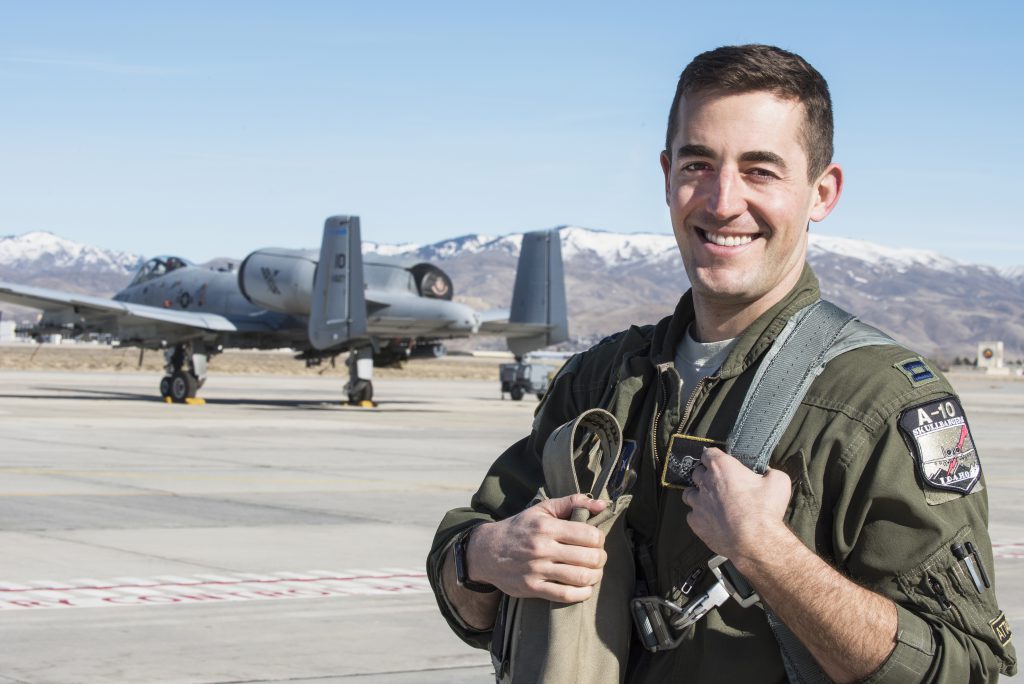
By Master Sgt. Becky Vanshur
Idaho Military Division Public Affairs
GOWEN FIELD, Idaho — Spend a day flying with Capt. Mike Shufeldt, one of the Idaho National Guard’s A-10 Thunderbolt II pilots, and feel firsthand what it is like to be an A-10 fighter pilot.
He can smell the strong scent of coffee brewing from the kitchen, as he brushes his teeth. It’s early in the morning, but his dog, Poppy, sits at his heels patiently waiting with a ball in her mouth and tail wagging. Shufeldt grabs his thermos of coffee, throws the ball a couple of times for Poppy, pats her furry head and walks out the door.
The commute across the Treasure Valley isn’t too bad as he heads down the interstate, even with the sun shining in his eyes as it rises above the beautiful Idaho foothills. Shufeldt approaches the main gate of Gowen Field, Boise’s Air Terminal and National Guard Base, with a smile on his face. Today is a good day to fly the mighty A-10 over the nearby Orchard Combat Training Center.
Shufeldt enters the building of the 190th Fighter Squadron and prepares for his day. He gets dressed in his flight G-suit, then his harness for his seat and parachute, and he grabs his high-tech flight helmet. Preparing for his flight and the training mission can take up to two hours. At the operations desk, he listens to his step brief. Today, he is called Bang 11.
The step brief is for him and his wingman, the additional pilot flying the second aircraft on this morning’s training mission. They are briefed on the weather, coordinates, weapons and the close air support mission they are about to fly.
“Bang 11, you are clear to step. Attack,” are the last words said before he heads out to the flight line where his A-10, commonly referred to as a Warthog, is patiently waiting. It is nearing 9 a.m. as he begins the 45-minute preflight check. He walks around his A-10, scanning for any visible issues.
“I do a full preflight inspection on the outside of the jet, to make sure there isn’t anything I see wrong,” said Shufeldt. “Usually there isn’t because our crew chiefs and our maintainers are really good. They are the best, actually.”
He climbs up the ladder and straps into his seat. He and his crew chief turn on the auxiliary power unit and fire up the twin turbine engines. “Clear on one,” said Shufeldt. “Good start on one,” is the response. “Clear on two.” “Two is clear,” is echoed back to him and the two engines are now fired up.
“We check everything, from the brakes to the rudders to the digital systems inside the jet,” said Shufeldt.
Both Warthogs are now ready for flight. “Pull the chalks, see you soon,” said Shufeldt. He disconnects with his crew chief, they salute and he taxis to the runway, stopping near the end to have his A-10’s weapons armed.
The powerful Warthogs line up. Shufeldt is out front. Once cleared for takeoff, he steps firmly on the brakes and runs up the engines. As he eases the throttles forward, the 12-and-a-half-ton beast starts to shake as it reaches nearly 20,000 pounds of thrust.
After checking his gauges and instruments, he pushes the throttles to maximum and releases the brakes. The mighty Warthog gains speed quickly, reaching approximately 150 miles per hour before he pulls back on the stick and the tires leave the runway.
He is up in the air. He takes a deep breath. A moment of calm, but it is short-lived as he begins his in-flight checks and focuses on the mission. He flies toward the target area.
The sun is just above and to the left, the heat from its rays beating down on his neck, the only portion of skin that is exposed.
He can see several dirt roads below in the vast desert and sagebrush-filled land of the OCTC as he approaches the target area near the ground troops below. They are providing ground support while shooting training targets.
“Bang 11 in from the south, guns,” said Shufeldt. “Bang 11, cleared hot,” said the ground troop on the radio below, providing Shufeldt clearance to shoot the 30 mm Gatling gun. “Bang 11, good hits,” is heard after the rounds are fired.
After expending all weapons, he has completed the training mission. Before flying back to Boise, the pilots check each other’s aircraft for any issues. This is called a battle damage check. The A-10s fly wingtip to wingtip, then Shufeldt dips below his wingman’s aircraft and looks up, checking the belly of the A-10. They switch positions and fly back in formation to Gowen Field.
Shufeldt lands, taxis the satisfied Warthog back to the flight line and parks in the same spot in which he started. He reverses the order of the prefight for the shutdown procedures with the crew chief. Once inside, he debriefs the mission with his wingman. It is nearing 1:30 in the afternoon and he is hungry. He warms his lunch, a stir-fry he cooked the night before.
Pilots, like any Airman, have additional military training and duties. He completes these, spends an hour at the gym and heads home.
He walks through the front door with barely enough time to close the door behind him as Poppy jumps up as high as she can, almost knocking him over. Shufeldt is home now after a day in his life as an A-10 fighter pilot.
Leadership is the most important component in any organization
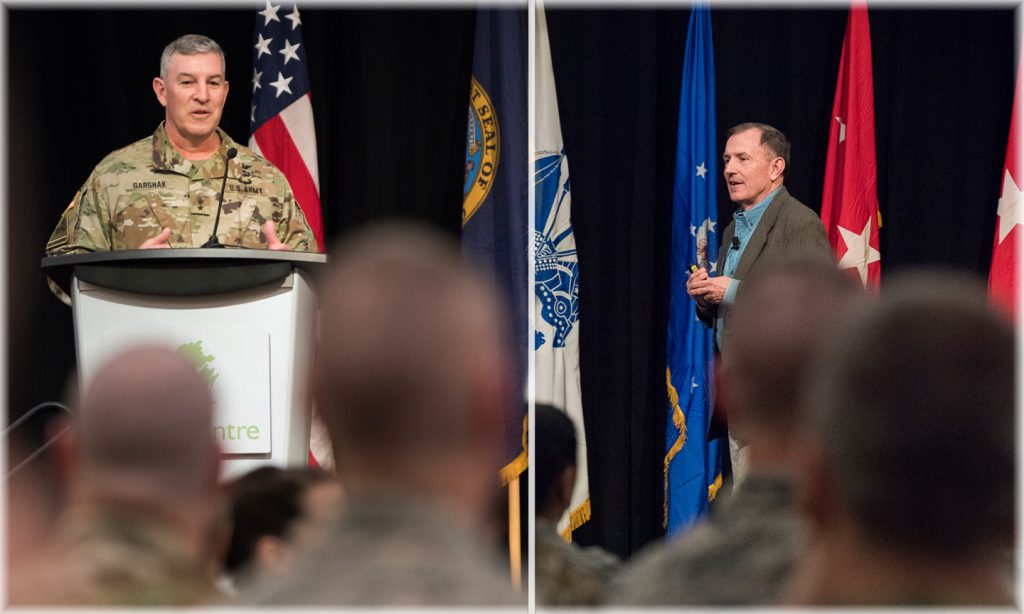
By Master Sgt. Becky Vanshur
Idaho Military Division Public Affairs
The Idaho National Guard held its annual adjutant general’s leadership conference focusing on what makes a successful leader. The joint conference on Feb. 22, held at the downtown Boise Centre, brought together leaders from the Idaho Army National Guard and the Idaho Air National Guard with several keynote speakers and informative breakouts for the daytime event, followed with the Family Programs Awards Ceremony and Banquet the same evening.
“Leadership is the most important component in any organization,” said Maj. Gen. Michael Garshak, adjutant general of Idaho. “We have tremendous leaders throughout the Idaho National Guard. This is not about fixing what may be broken, but continuing to grow and develop as leaders to make our organization even better. Our Soldiers and Airmen deserve the best leadership we can provide.”
Mr. Tom Greco was the daytime event’s primary speaker. He is Idaho’s civilian aide to the secretary of the Army and a retired combat veteran.
“Everything rises and falls on leadership,” said Greco. “If you don’t have the right location, you move. If you don’t have the right people in your organization, you go out and hire them. If you have the right people, but they don’t have the right skills, you train them. But if you don’t have the leadership in your unit, you are sunk. Everything rises and falls upon leadership.”
His advice on successful leadership can be summed into a list: leaders have a vision, leaders lead with integrity, leaders are credible, leaders are decisive, leaders are communicators, leaders are risk-takers, leaders are mentors, leaders are generous, leaders have balance, leaders are listeners and leaders are learners.
The night banquet event was about recognizing the accomplishments of the Idaho National Guard, and taking the time to recognize outstanding contributions by individual members, volunteers and family members within the organization.
The ceremony recognized the recipient of the 2019 Governor’s Outstanding Unit Award, given to Detachment 2, Charlie Company, 1-168th General Support Aviation Battalion. The annual award is given to a high performing unit whose contributions exemplify the highest levels of excellence.
Family Programs also awarded Amanda Signorio, 25th Army Band, Lt. Col. Christina Taylor, Cassandra Rzepa, Colter McBride, Sgt. 1st Class Dustin Dyer, and Newby-Ginnings a supportive business located in Northern Idaho, founded by Theresa Hart for outstanding achievement and selflessly devoting hundreds of hours of volunteer service.
The annual Clinton R. Taylor Integrity in Leadership award was presented to Lt. Col. John Williams from the 124th Operations Squadron, Capt. William Miller from the 2nd of the 116th Cavalry Armor Battalion, Senior Master Sgt. Shallan Prickett from the 124th Logistics Readiness Squadron and 1st Sgt. Sheldon Stace from Charlie Company 145th Brigade Support Battalion. The Integrity and Leadership award is given to individuals with exemplary traits in trust, mentorship, attitude, empowerment, resiliency, courage, professionalism and community service.
Idaho Military Division supports community, youth through STEM Matters Day
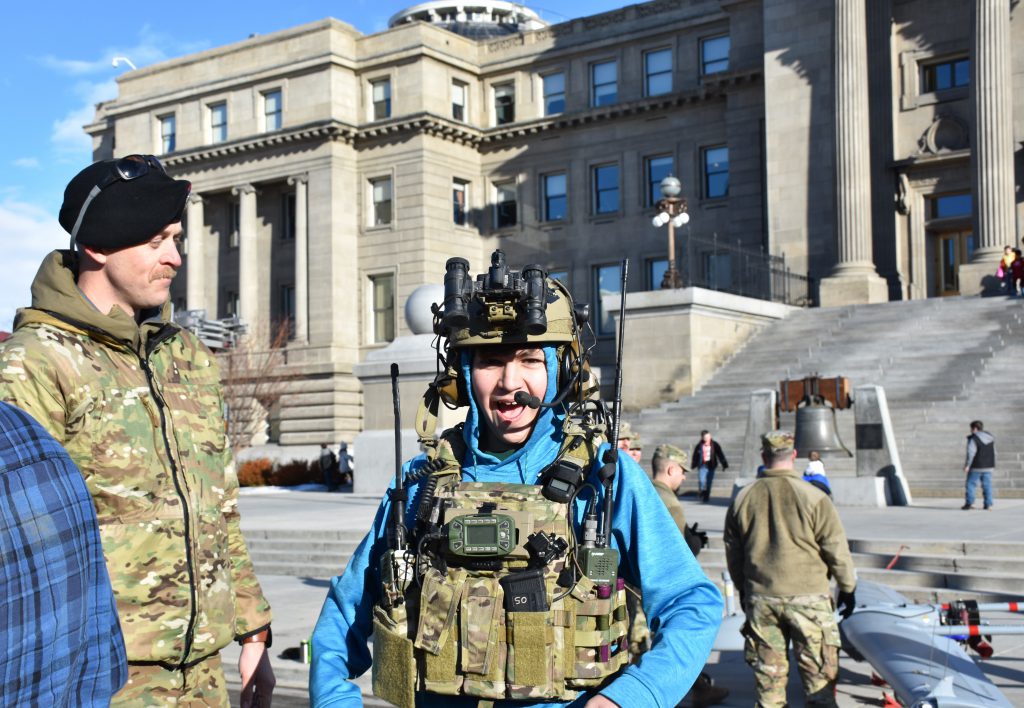
Story by Crystal Farris
Idaho Army National Guard
Members from the Idaho Military Division joined Gov. Brad Little, state legislators and various local organizations Jan. 15 at the Idaho State Capitol in support of the fifth annual Idaho STEM Matters Day.
The event provided free, hands-on educational opportunities for K-12 students, families and community members across the Treasure Valley looking to explore science, technology, engineering and mathematics.
It also gave the Idaho Military Division the opportunity to familiarize visitors with the various STEM-related careers available within its organization, said Capt. Gregg Miller an intelligence, surveillance and reconnaissance liaison officer for the Idaho Air National Guard’s 124th Air Support Operations Squadron.
“Our overall mission is to advise and assist the Army in the use of air assets for kinetic strikes on the battlefield,” said Miller. “It’s important we recognize that STEM is part of many things we do in this job and throughout the military. One example is the use of radar, which helps us to maintain positive control of air assets and ensure ground forces are properly supported.”
The team of ASOS Airmen were one of several Idaho Military Division representatives to participate in the event. Others included the 101st Civil Support Team, the 116th Brigade Engineer Battalion, the 2nd Battalion of the 116th Cavalry Regiment and the Idaho Office of Emergency Management.
Each representative provided information and familiarized visitors with their equipment on display, which included the 101st CST’s mobile Analytic Laboratory System; the 116th BEB’s RQ-7B Shadow unmanned aircraft system; the 124th ASOS’s MRZR all-terrain vehicle; and the IOEM’s Mobile Communications Vehicle.
The ASOS’s MRZR is a good example of a high-tech vehicle that enables military personnel to quickly traverse all types of terrain and environments, said Miller. However, it is just one of many pieces of equipment the organization depends on daily to conduct operations, he added.
In addition to STEM equipment, STEM-related careers are widely available within the Idaho Military Division and include professions in the medical, cyber, communications, construction, intelligence and logistical fields.
“The military has so many cool STEM jobs around the world,” said Angela Hemingway, Idaho STEM Action Center executive director. “Having the Idaho Guard at this event helped kids engage with all types of STEM professionals and showcased the diversity of job opportunities available to them right here in our amazing state.”
The annual Idaho STEM Action Center event promotes a prosperous STEM-literate Idaho by introducing communities to STEM opportunities and highlighting students, community members and industries making positive impacts in the field, Hemingway said.
In addition to members of the Idaho National Guard and Idaho Office of Emergency Management, the Boise State University Children’s Center, Discovery Center of Idaho, First Tech Challenge, Idaho Commission for Libraries, Idaho National Laboratory and Micron also participated.
Hosts provided guests with various interactive displays and activities involving building blocks, Legos, robotics, virtual reality devices and more. Each station incorporated some aspect of science, technology, engineering or mathematics designed to motivate guests to apply STEM-skills such as collaboration, critical thinking and problem-solving.
Idaho Guardsman lifts her way to record-setting achievements
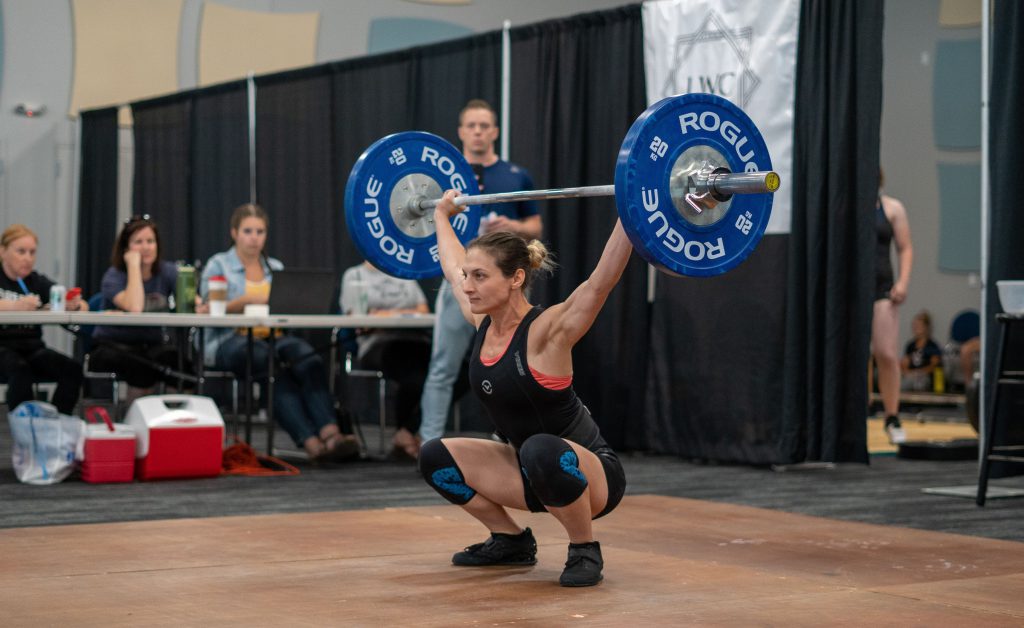
Story by Crystal Farris
Idaho Army National Guard
Idaho Army National Guardsman 1st Lt. Juanita “Christie” Goodrich’s road to fitness started in 2014 with a hankering for a mocha coffee, but also a desire to get in shape. She decided to run for the coffee instead of drive. The coffee-runs became a daily routine, motivating her to first run nine miles, then 12 and finally 20.
“At some point, I cut out the coffee part and was just straight running,” said Goodrich. “Or I’d grab a water at the coffee shop and keep running.”
Those runs were a defining moment in her life that eventually led her to become the athlete she is today and a six-time Idaho state championship winner in Olympic weightlifting.
However, it was only after developing shin splints that Goodrich found her passion in CrossFit and later Olympic lifting. Being homeschooled, she had never participated in competitive sports while growing up. CrossFit and Olympic lifting gave her an outlet, she said, to express her competitive side and make up for lost time.
“I had never done anything like that before but from the moment I entered the CrossFit gym I fell in love,” said Goodrich. “Pushing myself, going from being in the bottom of the group to the first one done with the workout of the day, was so much fun. I couldn’t get enough.”
While attending CrossFit, Goodrich learned about Olympic weightlifting. The sport involves two lifts, the snatch and the clean-and-jerk, which both require the athlete to lift a weighted barbell above their head in either one or two motions.
The lifts are difficult and require time to develop appropriate technique, Goodrich said, which is the part she enjoys most. She began training for competitions in 2017 and has since set multiple Idaho state records for the sport in her weight division.
“When I started doing those lifts and movements, I just loved them,” said Goodrich. “They are so technical and it takes so much time to learn, but it’s really fun competing and I’ve done well, so why not continue?”
In 2017, she took home first-place in the 53 kilogram (approximately 116 pound) weight division, setting state records for the snatch by lifting 69 kilograms and 84 kilograms in the clean-and-jerk. She also set the record for the total of both events by lifting a combined weight of 153 kilograms, winning overall best female lifter at the 2017 Idaho State Weightlifting Championships.
After taking a break from competing to have her first child, Goodrich returned to weightlifting in May. She competed again in August, setting the Idaho state records in the 49 kilogram weight class for the snatch, clean-and-jerk and the total, lifting 62 kilograms for the snatch, 75 kilograms for the clean-and-jerk and a total of 153 kilograms.
Two days later Goodrich found out she was pregnant with her second child. However, not ready to slow down, she competed again in October at the 2019 Idaho State Weightlifting Championships, where she took home best female lifter for the second time.
“I didn’t hit the numbers I have in the past,” said Goodrich. “But I’m pregnant and still got best female lifter, so I’m happy with my results.”
Her goal is to one day compete in a national-level event. Goodrich said having children has only postponed that goal, not changed it. She has qualified to compete in nationals twice and plans to qualify again after having her second child.
“I’ll always be pushing toward that goal because I want to have something my kids can be proud of me for and to show them what can be accomplished with hard work.”
Idaho Guardsmen serve together in childhood town as commander, first sergeant
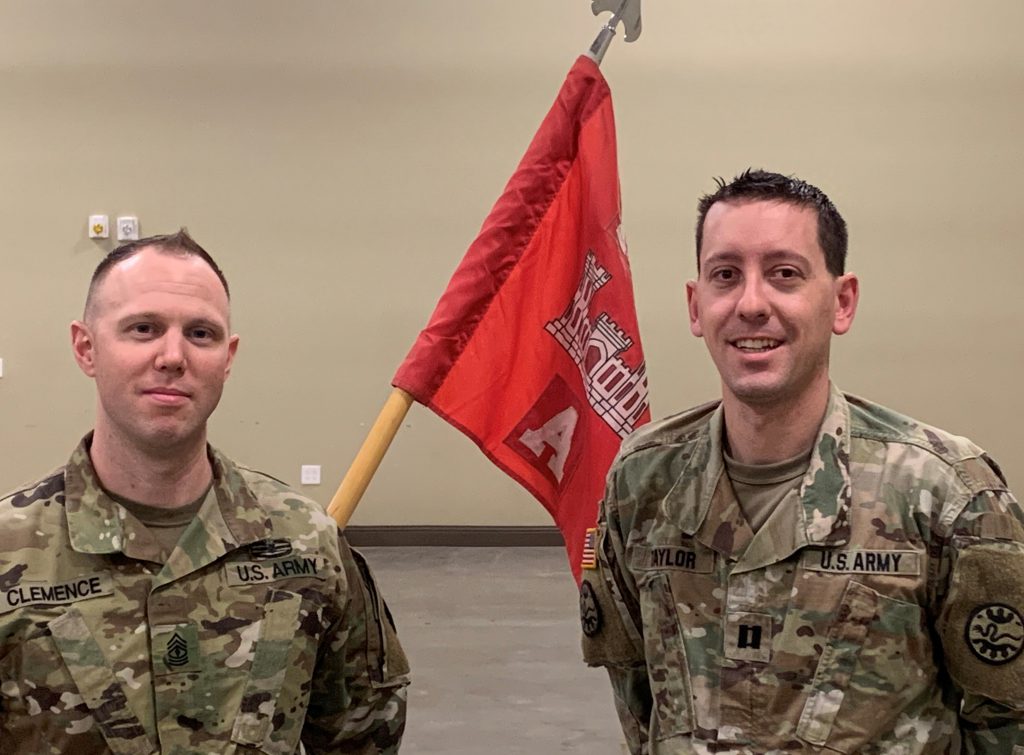
Story by Crystal Farris
Idaho Army National Guard
Idaho Army National Guard Soldiers Capt. Robert Taylor and 1st Sgt. Derek Clemence share a similar past; they grew up in the small town of Mountain Home, Idaho, and both shipped off to basic training shortly after graduating from Mountain Home High School in 2002.
Approximately 18 years later, both Guardsmen were reunited in their childhood town to serve as commander and first sergeant of A Company, 116th Brigade Engineer Battalion, headquartered in Mountain Home.
“It’s great to be part of a team so deeply rooted in the same town,” said Taylor. “That type of thing only happens in the National Guard and is what the Guard is all about; community, being tied to where you serve and serving with your neighbors.”
In October, Taylor took command of the company, which provides engineer support to the 116th Cavalry Brigade Combat Team. Clemence became the company’s first sergeant one month later.
“I was excited to find out that Capt. Taylor is the commander of A Company,” said Clemence. “The unit being in our old hometown makes me feel closer to the community and gives me the perspective that we are now assets to the community from which we came.”
While Taylor enlisted into the Idaho Army National Guard as a paralegal specialist the day before he began his senior year of high school, Clemence enlisted into the organization’s military police platoon two-years later.
Both Soldiers came face-to-face for the first time since high school while on a deployment to Iraq in 2004 and did not see each other again for 10 more years.
“I had no idea Clemence was still in the Guard until about three years ago when my old unit was doing night training,” said Taylor. “He was giving the mission safety brief. I remember thinking how great it was that a guy I went to high school with had become a sergeant first class and was giving me the brief for a mission I was about to go on. Now he is my first sergeant.”
Clemence served as a military police sergeant for 13 years before he transitioned as an engineer to the 116th Brigade Engineer Battalion in 2016. Coming from a long line of veterans, Clemence knew serving was something he wanted to do since childhood, he said.
“I remember cleaning my old house one day and finding a journal from my fifth-grade English class,” said Clemence. “My teacher had me write about different daily topics. One topic was on what I wanted to be when I grew up. I wrote that I wanted to join the military as my uncle did.”
Taylor, like Clemence, knew he wanted to follow in his family’s footsteps by joining the military. His mother served in the active Air Force for 20 years and retired while stationed at Mountain Home Air Force Base. Taylor joined the Guard rather than active duty as a means to pursue his military career while it paid for school.
“I joined the guard because I saw it as a way to attend law school and still pursue my military career,” said Taylor. “I was concerned that if I went on active duty right out of high school, I wouldn’t have the desire to go back to school later.”
After returning from deployment, Taylor commissioned as an engineer officer and earned an undergraduate in public relations from the University of Idaho. In 2013, he graduated law school and started a family law practice in Mountain Home.
Both Guardsmen will deploy together again in 2020 when the 116th Cavalry Brigade Combat Team mobilizes to Europe for Defender 2020 in support of the largest deployment of U.S. based forces to Europe for an exercise in the last 25 years.
New vehicle Vismods could transform Army training
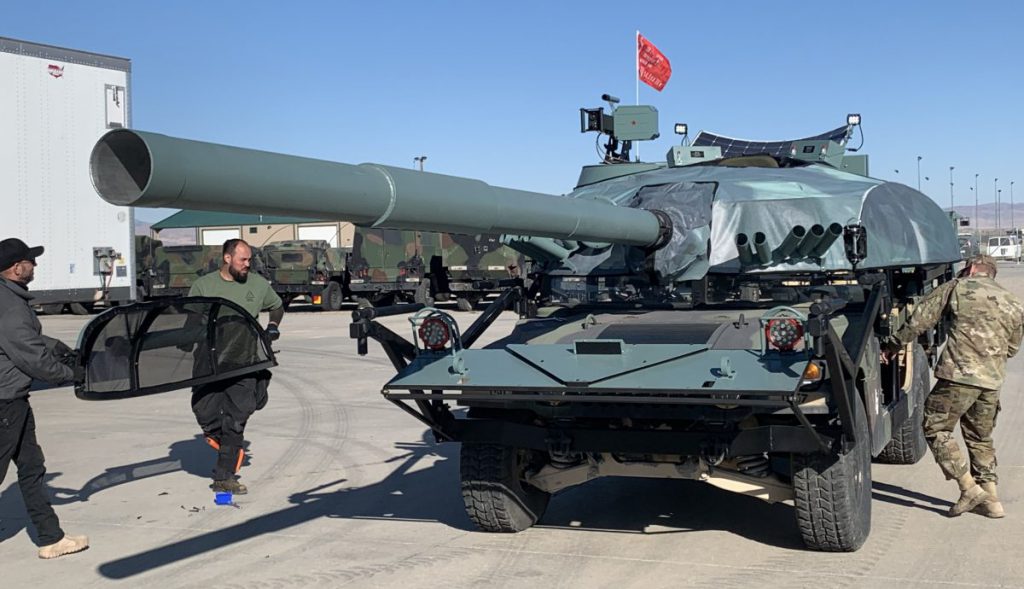
Story by Crystal Farris
Idaho Army National Guard
The National Guard Bureau has partnered with a Hollywood special effects company to make future training more realistic for brigade combat teams during Exportable Combat Training Capability exercises.
The improvements involve a new visual modification kit that will transform the Army’s M1097 HMMWV into simulated Russian T-72 Main Battle Tanks and BTR-90 Personnel Carriers.
While BCTs already use variations of visual modifications – plastic, fiberglass, and sheet metal – to replicate enemy vehicles, these new kits are the first of their kind, said Maj. Aaron Ammerman, XCTC program manager for the NGB.
“Taking a look at how VisMods are done across the Army, I think these are the best I’ve ever seen,” said Ammerman. “They will provide an exponentially more realistic threat signature for troops to train against as they do force-on-force exercises.”
In 2018, NGB contracted Westefx in an effort to improve the XCTC program and its 21-day combat training exercises that ready units for mobilization. The company has provided special effects for movies such as “James Bond”, “Taken” and “Men in Black II”. They have also participated in approximately 50 XCTC rotations by providing battlefield effects, props and equipment for the military over the last 10 years.
Westefx owner and lead designer Erick Brennan said the new VisMods will provide Soldiers with realistic identification and engagement training through their effective noise and visual signals.
“No enhanced battlefield training simulators can compare with the functionality, realism, durability and cost-effectiveness of this new VisMod vehicle,” said Brennan. “They are pretty amazing and we are really proud of them.”
The kits – each weighing approximately 1,700 pounds and fitting over the chassis of a Humvee – resemble the size and silhouette of the tank and personnel carrier but with an inflatable canvas-like frame.
Its gas-operated weapon systems simulate the firing of .50 Cal and 125mm main guns that can be configured to multiple integrated laser engagement systems. The MILES gear, along with the kit’s smoke generator, will enable Soldiers to track and simulate target acquisition.
“We will be able to train against a realistic enemy,” said Sgt. 1st Class Clinton Doramus, Idaho Army National Guard VisMod fleet manager. “These kits aren’t going to look and act like a Humvee. They are going to look and act like T-72s and BTR-90s.”
While exponentially more realistic than previous VisMod vehicles, these kits also provide a more cost -effective alternative to the military than using actual tanks and personnel carriers. The Humvee cost less and the Army has more of them.
“A Humvee costs approximately $30,000 plus another maybe $5,000 to maintain for the year, whereas an M1A1 tank costs a lot more,” said Doramus. “It’s initial and maintenance expenses that make these kits a lot more cost-effective to do on Humvees than tanks or Bradleys. Plus the Army doesn’t just have 60 spare tanks sitting around somewhere.”
Doramus and a team of Idaho Guardsmen, mostly comprised of engineers and mechanics, helped Westefx install 12 completed kits onto Humvees at the Idaho Army National Guard’s Orchard Combat Training Center. The team has spent more than a year assembling and maintaining the fleet of 60 Humvees allocated for installation. NGB and Westefx plan to continue production of 48 more kits over the next three years.
Idaho National Guard conducts engineer, medical and leadership exchange in Cambodia
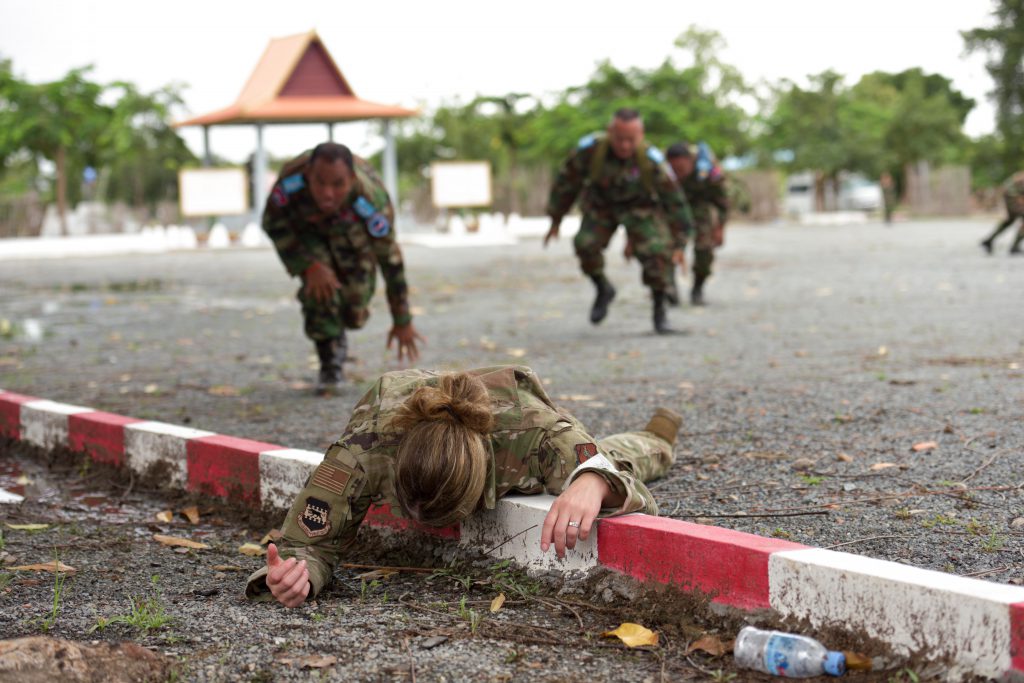
PHNOM PENH, CAMBODIA
Story by Capt. Robert Taylor
Idaho Army National Guard
Idaho National Guard Soldiers and Airmen participated in a subject-matter expert exchange Sept. 16–20 at the United Nations Peacekeeping Operations center with members of the Royal Cambodian Armed Forces.
The mission was part of the National Guard’s State Partnership Program and included a team of four Idaho Army National Guard Soldiers and two 124th Fighter Wing Airmen. Subject-matter expert exchanges facilitate the exchange of ideas, capabilities, training and experience between a host country and a state’s National Guard.
“These exchanges provide a great opportunity for our Idaho Guardsmen to not only train along side Cambodian Soldiers, but to also learn and grow, both personally and professionally,” said Maj. Gen. Michael Garshak, adjutant general of Idaho.
Garshak and a small team of Idaho National Guardsmen also spent the week in Cambodia meeting with embassy officials and discussing ways to better collaborate across issues of defense cooperation.
Soldiers and Airmen spent the week training with members of Cambodia’s peacekeeping directorate who are preparing to deploy to several countries as part of the National Center for Peacekeeping, Mines, and Explosive Remnants of War Clearance program. More than 70 NPMEC Soldiers made up three groups consisting of engineer, medical and leadership engagements.
“It was an amazing experience,” said Tech. Sgt. Kelly Goodman. “Their ingenuity is through the roof.”
Throughout the week, Goodman and Lt. Col. Brandon Pieper, explored basic first aid and CPR techniques with NPMEC Soldiers.
Pieper, a traditional Guardsman and dentist from Boise, Idaho, said he volunteered to participate in the exchange to get outside of his comfort zone of providing dental exams during drill weekend. In addition, he wanted to work with members of the Idaho Army National Guard.
He said the experience gave him a similar perspective to deploying with the Army and having to form a team with people he doesn’t normally work with.
Engineer Soldiers from both armies worked together to build a 30-foot beam bridge over a creek to increase their shared understanding of bridging concepts. The bridge will allow future students at the PKO to access the facility’s helicopter pad faster.
“Working with the NPMEC Soldiers left me energized each day with their enthusiasm of learning,” said Maj. Steve Keeton, an engineer officer.
Soldiers also reviewed and practiced troop leading procedures, land navigation and basic leadership skills together.
The exchange occurred during the Cambodia’s Pchum Ben, a 15-day religious festival, which gave Soldiers and Airmen the chance to visit a nearby temple and experience the country’s culture firsthand. Idaho and Cambodia have participated in the State Partnership Program since 2009. Soldiers and Airmen from the Idaho National Guard conduct approximately four subject-matter expert exchanges in Cambodia each year.
Idaho Army National Guard prepares for new combat fitness test

Story by Crystal Farris
Idaho Army National Guard
In October, the new Army Combat Fitness Test will be introduced throughout its ranks. Within the following 12 months, Reserve and National Guard Soldiers are expected to complete one not-for-record ACFT before it becomes the official for-record test in October 2020.
To prepare, the Idaho Army National Guard is taking a deliberate but active approach to ease logistical concerns, limit injuries and ensure overall success, said Command Sgt. Maj. Scott White, State Command Sergeant Major.
“Currently we are in the crawl phase of this transition,” said White. “We want to approach this methodically to take the Soldiers’ uncertainty out of it and provide units a comfort level before they even start thinking about running a test.”
Over the last six months, master fitness trainers have demonstrated the new test for units throughout the state. The demonstrations offer Soldiers insight into expectations and how to accurately conduct the six-event test.
During a demonstration on Gowen Field August 3, Soldiers with the state’s Joint Forces Headquarters had the opportunity to attempt events and receive feedback on form and ways to achieve better results.
“I think it may have been a shock to some of our Soldiers that there is such a contrast in physical demands between the current Army Physical Fitness Test and the ACFT,” said 1st Sgt. Valerie Walts. “Once we attempted some of the events a lot of them were a bit surprised how draining performing the entire test in a timed setting is going to be.”
The new test events are the three-repetition maximum deadlift, standing power throw, hand-release push-up, sprint-drag-carry, leg tuck and two-mile run. They require different techniques and body mechanics than the current three-event APFT does, explained Staff Sgt. Esteban Gonzalez, the state’s lead MFT. It also requires various types of equipment, unlike the APFT that requires none.
This fall, Idaho will receive approximately 800 lanes of equipment that include hexagon barbells, nylon drag sleds and medicine balls. The fielding will bring the Idaho Army National Guard into its walk-phase of the fitness transition by enabling it to conduct diagnostic tests and certify Soldiers who will be responsible for grading it.
However, there are ways individuals can train on their own now and with little to no equipment. Guidance on exercises, drills and sample training aids can be found at www.army.mil/acft. The website also offers other resources such as the Center for Army Lessons Learned Manual, an equipment list and a testing manual.
It is important Soldiers understand their current physical abilities and start training while there is still time, Gonzalez said. MFTs can provide Soldiers personal training advice and help units prepare by offering training plans and certifying graders.
“We strongly recommend using the MFTs and our demonstrations so that when it comes time to conduct the ACFT Soldiers are comfortable and ready,” he said. “MFTs are one of the best benefits available to Soldiers. As long as individuals are dedicated to showing up, the MFTs are willing to work with them.”
Back to Newsroom
JOIN the Idaho Army National Guard
Gowen Field Firefighters Learn Firsthand About Flashover – “Near Certain Death”
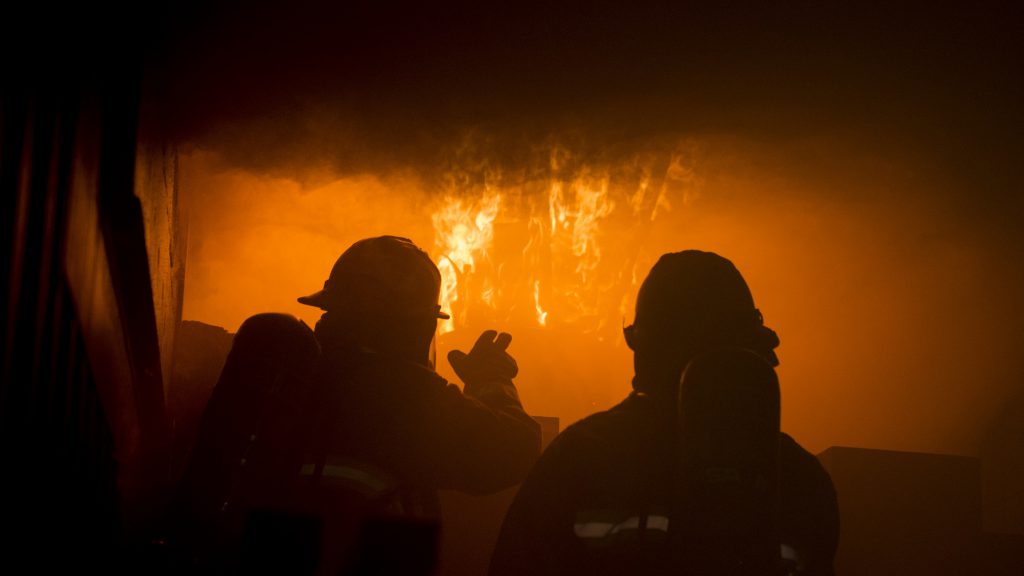
Story by Ryan White
124th Fighter Wing
Firefighters from Gowen Field participated in a unique flashover-training course, Sept. 11-13, 2019, Gowen Field, Boise, Idaho.
The course allowed for nearly 30 firefighters from the Gowen Field Fire Department and four firefighters from the Orchard Combat Training Center to perform live fire training in a controlled environment. It consisted of four hours of lecture and four hours in a specialized burn trailer.
“This is one of those training opportunities that every firefighter who goes through it remembers,” said SSgt. Reginald Pierce III, a firefighter with the Gowen Field Fire Department and primary instructor for the training.
Flashover happens when all contents in a room hit their combustion point and ignite at the same time in a flash. The training provided an opportunity to see what flashover looks like and figure out how to deal with it, how to prevent it, and how to react and escape if encountered.
“If a firefighter is in a structure fire and the room flashes, it’s near certain death,” said Pierce. “You have two seconds, as a firefighter in your full gear, to make it out of that situation before your gear fails. That’s why this training is so important.”
According to Pierce, the training helps build confidence in equipment, demonstrates what temperature ratings gear can handle and also teaches firemen how to utilize water in this type of scenario.
“For some of these guys, it’s the first time they are seeing real fire because fire school only uses propane,” said SSgt Jack Simonds, a firefighter with the Gowen Field Fire Department and assistant instructor for the training.
The live fire is done in a specialized mobile burn trailer. The upper part of the trailer is a burn chamber and the lower middle area is a classroom. A burn barrel filled with wood is lit in the center of the chamber and ignites the walls and roof, which are lined with oriented strand board. The off-gassing of the wood igniting then causes fire to rollover the firefighters’ heads as the room heats up to over 700 degrees.
“In fire school, you’re learning strategy and techniques,” said Simonds. “Here, there’s nothing about strategy and technique. All we’re doing is studying the fire. We’re not trying to fight it. We’re trying to watch it and learn from it—see how it’s going to go up the ceiling and how the heat is going to come down the wall and light on fire.”
Now that they’ve had this training, Pierce believes the firefighters will be able to quickly see signs of a possible flashover and decide if they should fight a fire defensively from the outside. Knowing those signs can be the difference between near certain death and living to fight fire another day.
Back to Newsroom
Join the Idaho Air National Guard
Idaho Army National Guard’s best warriors – Barrera, Crockett
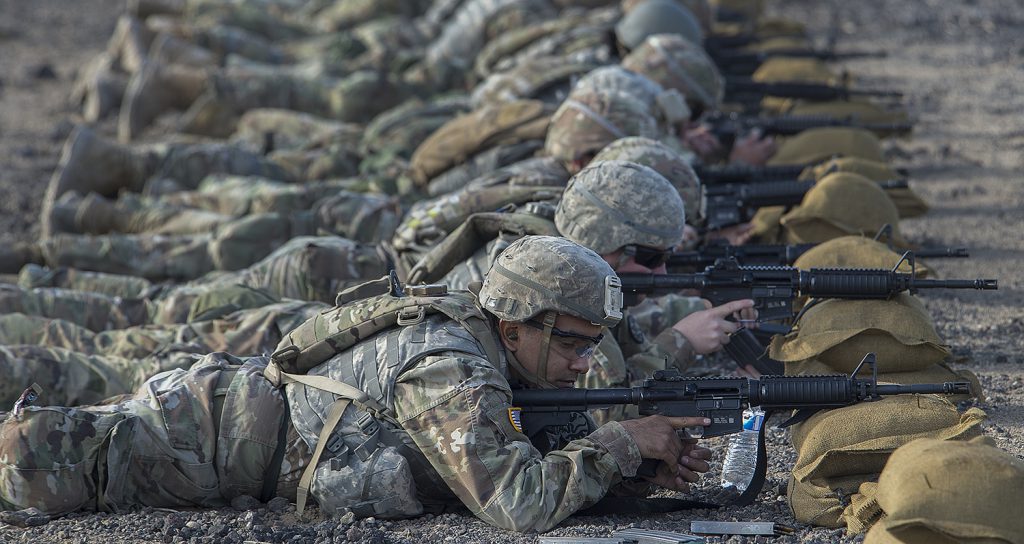
Story by Capt. Robert Taylor
Idaho Army National Guard
After three days of intense competition during the Idaho National Guard’s Best Warrior Competition, Sgt. Roy Barrera Jr. and Spc. Colton Crockett were recognized as the Noncommissioned Officer and Soldier of the Year.
Throughout the competition, four NCOs and 11 Soldiers from across the state competed in the event held at Gowen Field and the Orchard Combat Training Center Sep. 5-7.
“This competition is about the warrior spirit,” said Brig. Gen. Farin Schwartz, commander, Idaho Army National Guard.
Barrera Jr. and Crockett both serve in the 116th Cavalry Brigade Combat Team. Barrera Jr. is in the brigade’s headquarters company and Crockett serves in the 2nd Battalion, 116th Cavalry Regiment.
Sgt. Andrew Henson, also from 2-116 CAV REG, finished second in the NCO category. Sgt. Jordan Hudson and Cpl. Juan Campos also competed to be the state’s top NCO.
Spc. Alex Amour finished as the runner up for the Soldier category. Spc. Jonathon Ames, Pfc. Rodney Farichild, Spc. Jaslyn Greco, Prf. Connor Hensley, Spc. Isaac Morado, Pfc. Adam Nichols, Pfc. Nathan Rands, Pfc. Benjamin Rudolph and Spc. Dakota Woodwick also competed in the completion.
“These Soldiers are a great representative of the Idaho Army National Guard,” Schwartz said. “Their high level of physical fitness and mental fitness separates them from their peers.”
Competitors were tested on numerous Army Warrior Tasks, including their ability to disassemble and reassemble multiple weapons; land navigation at day and night; ruck marching; shooting; combatives; first aid and the Army’s new Army Combat Fitness Test. Competitors were stressed physically with little sleep to push them to their limits.
 Official Government Website
Official Government Website